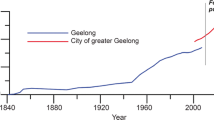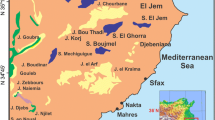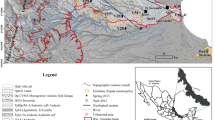Abstract
Stable isotopes of H2O are used to define the hyporheic–hypolentic boundary in Ledbetter Creek as it discharges to Kentucky Lake, a constructed reservoir in western Kentucky, USA. High-resolution (centimeter-scale) sample collection and analysis were utilized to determine one-dimensional variations in δ2H and δ18O of H2O and chloride (Cl−) across the boundary. During reservoir low stand in winter, the hyporheic–hypolentic zone contains water from Ledbetter Creek and groundwater separated by an interface at ~10 cm below the channel bottom. Following reservoir-stage increase in spring and summer, water from Kentucky Lake infiltrates into the hyporheic–hypolentic zone to a depth of at least 18 cm below the channel bottom. Reservoir-stage decline in autumn causes source-water mixing, largely obscuring the hyporheic–hypolentic boundary. Stable isotopes provide an effective complement to conventional tracers for delineation of water masses within the hyporheic–hypolentic zone.
Résumé
L’utilisation des isotopes stables de la molécule d’eau a permis de définir l’interface hyporhéique-hypolentique dans la Ledbetter Creek, au point de déversement dans le réservoir artificiel que constitue le Kentucky Lake (Ouest du Kentucky, Etats-Unis). Une campagne de prélèvements à haute résolution (échelle centimétrique) a contribué à déterminer les variations unidimensionnelles des valeurs de δ2H et de δ18O de la molécule d’eau et de la concentration en chlorures (Cl−) de part et d’autre de l’interface. En hiver, lorsque le niveau du réservoir est minimal, la zone hyporhéique-hypolentique contient de l’eau de la Ledbetter Creek et de l’eau souterraine, séparées par un interface situé environ 10 cm sous le fond du chenal. Suite aux recharges printanières et estivales, l’eau du Kentucky Lake envahit la zone hyporhéique-hypolentique sur plus de 18 cm sous le fond du chenal. En automne, la baisse de niveau dans le réservoir occasionne un mélange des eaux, rendant diffus l’interface hyporhéique-hypolentique. Les isotopes stables constituent ainsi un complément efficace aux traceurs conventionnels pour la délimitation des masses d’eau dans la zone hyporhéique-hypolentique.
Resumen
Se han utilizado isótopos estables del agua para definir el límite hiporreico-hipoléntico en Ledbetter Creek, que constituye una zona de descarga del lago Kentucky, una presa construida al Oeste de Kentucky, USA. Se ha llevado a cabo una recogida de muestras de alta resolución (a escala centimétrica) y se utilizaron los resultados para determinar las variaciones unidimensionales en δ2H y δ18O del H2O y los cloruros (Cl−) alrededor del límite. Durante la época de niveles bajos en invierno, la zona hiporreica-hipolentica tiene agua procedente de Ledbetter Creek y de agua subterránea separada por una interfase de ~10 cm debajo del límite del canal. Siguiendo el incremento de los niveles en la presa en primavera y verano, el agua del Lago Kentucky se infiltra en la zona hiporreica-hipoléntica hasta una profundidad de, al menos, 18 cm bajo el límite hiporreico-hipoléntico. Los isótopos estables aportan un complemento efectivo a los trazadores convencionales para la delimitación de masas de agua dentro de la zona hiporreica-hipoléntica.





Similar content being viewed by others
References
Bencala KE (1993) A perspective on stream-catchment connections. J North Am Benthol Soc 12(1):44–47
Brunke M, Gonser T (1997) The ecological significance of exchange processes between rivers and groundwater. Freshw Biol 37:1–33
Coffin DL (1970) A preliminary evaluation of bank storage associated with Libby Reservoir in northwestern Montana. USGS Water-Supply Paper 1899-L, USGS, Reston, VA
Coplen TB (1995) Reporting of stable hydrogen, carbon, and oxygen isotopic abundances. Geothermics 24(5–6):707–712
Craig H (1961) Isotopic variations in meteoric waters. Science 133:1702–1708
D’Angelo EM, Reddy KR (1994) Diagenesis of organic matter in a wetland receiving hypereutrophic water. I. Distribution of dissolved nutrients in the soil and water column. J Environ Qual 23:928–936
Davis RW, Lambert TW, Hansen AJ Jr (1973) Subsurface geology and ground-water resources of the Jackson Purchase region Kentucky. USGS Water-Supply Paper 1987, USGS, Reston, VA
Gat JR (1996) Oxygen and hydrogen isotopes in the hydrologic cycle. Ann Rev Earth Planetary Sci 24:225–262
Harvey JW, Bencala KE (1993) The effect of streambed topography on surface-subsurface water exchange in mountain catchments. Water Resour Res 29(1):89–98
Hesslein RH (1976) An in situ sampler for close interval pore water studies. Limnol Oceanogr 21(6):912–914
International Atomic Energy Agency (2006) Global Network of Isotopes in Precipitation. http://isohis.iaea.org. Cited 27 April 2006
Kingsbury JA, Hoos AB, Woodside MD (1999) Environmental setting and water-quality issues in the lower Tennessee Riverr basin. USGS Water-Resources Investigations Report 99–4080, USGS, Reston, VA
McKenna SA, Ingraham NL, Jacobson RL, Cochran GF (1992) A stable isotope study of bank storage mechanisms in the Truckee River basin. J Hydrol 134:203–219
National Atmospheric Deposition Program (2006) Illinois State Water Survey. http://nadp.sws.uiuc.edu/sites/siteinfo.asp?id=KY99&net=NADP. Cited 2 May 2006
Nelson ST (2000) A simple, practical methodology for routine VSMOW/SLAP normalization of water samples analyzed by continuous flow methods. Rapid Commun Mass Spectrom 14:1044–1046
Thompson KE (2002) Ground water flow in the Ledbetter Creek watershed, Calloway County, Kentucky. MSc Thesis, University of Kentucky, USA
Triska FJ, Kennedy VC, Avanzino RJ, Zellweger GW, Bencala KE (1989) Retention and transport of nutrients in a third-order stream in northwestern California: hyporheic processes. Ecology 70(6):1893–1905
UK Agricultural Weather Center (2006) University of Kentucky. http://wwwagwx.ca.uky.edu. Cited 2 May 2006
White DS (1993) Perspectives on defining and delineating hyporheic zones. J North Am Benthol Soc 12(1):61–69
Winter TC (2001) Ground water and surface water: the linkage tightens, but challenges remain. Hydrol Process 15:3605–3606
Winter TC, Harvey JW, Franke OL, Alley WM (1998) Ground water and surface water: a single resource. USGS Circular 1139, USGS, Reston, VA
Wondzell SM, Swanson FJ (1999) Floods, channel change, and the hyporheic zone. Water Resour Res 35(2):555–567
Yurista PM, White DS, Kipphut GW, Johnston K, Rice G, Hendricks SP (2004) Nutrient patterns in a mainstem reservoir, Kentucky Lake, USA, over a 10-year period. Lake Reserv Manage 20(2):148–163
Acknowledgements
The authors would like to thank the staff at the Hancock Biological Station, Murray State University, for their assistance and use of lab facilities and field equipment. We would also like to thank the staff at the Environmental Training and Research Laboratory, University of Kentucky, for their assistance in sample preparation and analysis. This project was funded by grants to the senior author from the Geological Society of America and the Brown-McFarlan Fund, Department of Earth and Environmental Sciences, University of Kentucky.
Author information
Authors and Affiliations
Corresponding author
Rights and permissions
About this article
Cite this article
Aseltyne, T.A., Rowe, H.D. & Fryar, A.E. Stable isotopic fingerprint of a hyporheic–hypolentic boundary in a reservoir. Hydrogeol J 14, 1688–1695 (2006). https://doi.org/10.1007/s10040-006-0088-2
Received:
Accepted:
Published:
Issue Date:
DOI: https://doi.org/10.1007/s10040-006-0088-2




